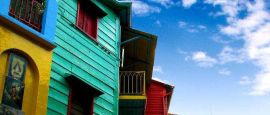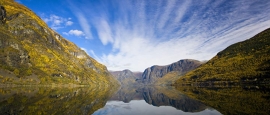Weather in Buenos Aires
Buenos Aires has a humid subtropical climate without extreme temperatures, so it is a year-round holiday destination.
Spring (September to November) is a great time to visit with temperatures hovering around 15°C (59°F) to 20°C (68°F). The city's residents come out of their winter hibernation and the jacaranda trees are blooming. A highlight of this time is La Noche de los Museums (The Night of the Museums) with over 250 museums and galleries open until late.
Summer (December to February) tends to be hot and humid, and with January being the warmest month (25°C/77°F), many locals leave the city for the coast.
Autumn (March to May) is the best time to visit Buenos Aires. The days are sunny yet the heat is not oppressive, and there aren't too many crowds. Art and film festivals galore too.
Winter (June to August) in Buenos Aires is mild with little chance of snow, but the days can be overcast and the nights chilly. June is a good time to find a hotel or flight bargain, although things pick up in July and August as it's the summer holidays in North America and Europe and families travel. Temperatures in winter range from 11°C (52°F) to 15°C (59°F).
Night
| Weather (night) | Temp (min night) | Rain (mm) | Wind (mph) | Humidity Pressure Visibility | ||
|---|---|---|---|---|---|---|
| Sun |
Fog
|
Fog |
1 5 °C |
0mm |
3
ne |
97%
1,021mb Poor |
| Mon |
Partly Cloudy Night
|
Partly cloudy skies |
1 7 °C |
0mm |
9
nne |
90%
1,017mb Good |
| Tue |
Occ Light Rain
|
Patchy rain possible |
2 0 °C |
0mm |
8
nnw |
83%
1,008mb Moderate |
| Wed |
Clear
|
Clear skies |
1 2 °C |
0mm |
7
ese |
61%
1,018mb Good |
| Thu |
Clear
|
Clear skies |
1 1 °C |
0mm |
4
e |
50%
1,020mb Good |
| Fri |
Clear
|
Clear skies |
1 2 °C |
0mm |
1
ne |
51%
1,022mb Good |
| Sat |
Clear
|
Clear skies |
1 0 °C |
0mm |
6
ene |
69%
1,025mb Good |
| Sun |
Clear
|
Clear skies |
8 °C |
0.1mm |
6
e |
62%
1,018mb Good |
| Mon |
Overcast
|
Overcast skies |
9 °C |
0.1mm |
13
ese |
79%
1,014mb Good |
- 0 to 30 is very low
- 31 to 50 is low
- 51 to 70 is moderate to low
- 71 to 80 is moderate
- 81 to 90 is moderate to high
- 91 to 100 is high
- Very poor - less than 1km
- Poor - between 1km and 4km
- Moderate - between 4km and 10km
- Good - between 10km and 20km
- Very good - between 20km and 40km
- Excellent - more than 40km
Temperature in Buenos Aires
Sunlight in Buenos Aires
Precipitation in Buenos Aires
Humidity in Buenos Aires
Do you have any Feedback about this page?
© 2025 Columbus Travel Media Ltd. All rights reserved. No part of this site may be reproduced without our written permission, click here for information on Columbus Content Solutions.








 You know where
You know where